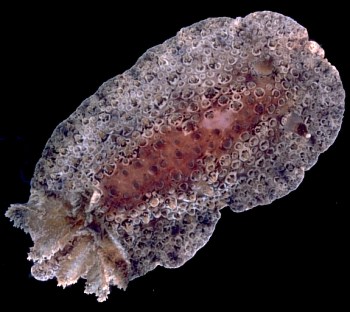
Hoplodoris nodulosa
(Angas, 1864)
Order: NUDIBRANCHIA
Suborder: DORIDINA
Superfamily: EUDORIDOIDEA
Family: Dorididae
DISTRIBUTION
Southern Australia from New South Wales to Western Australia. Also found throughout New Zealand
PHOTO
Upper right: White Horse Point, Balmain, Sydney, intertidal, Coll: I. Loch, 20 June 1982.[C133935] Lower left: Sandy Beach, N of Coffs Hbr, N NSW, intertidal, Coll: G. Avern, 20 May 1982. [C133693]. Lower right: Gerroa, NSW, 26 Sept. 1982, Coll: D. Bushell, intertidal.{C135412]. Photos: Bill Rudman.
Grows to about 40 mm. Densely pustulose mantle except in a median band behind the rhinophores where the pustules are often absent or very reduced in size. Colour normally a mottled brown or yellowish brown often with the median band being a darker colour than the rest of the mantle. It is common intertidally but is also found to about 8 m.
There are a number of other similar nodulose dorids which have recently been revised. See generic review of Hoplodoris. In New Zealand this species was known as Homoiodoris novaezelandiae Bergh, 1904 until Miller's review (1991) which showed that it was a species of Hoplodoris. On the evidence then available it was considered distinct from the eastern Australian Hoplodoris nodulosa. However, in Fahey & Gosliner's revision of the genus (2003), H. novaezelandiae is considered to be anatomically identical to H. nodulosa.
- Angas, G.F. (1864). Description d'espèces nouvelles appartenant à plusieurs genres de Mollusques Nudibranches des environs de Port-Jackson (Nouvelles-Galles du Sud), accompagnée de dessins faits d'après nature. Journal de Conchyliologie, 12: 43-70
- Fahey, S. J. & Gosliner, T. M. (2003) Mistaken identities: On the Discodorididae genera Hoplodoris Bergh, 1880 and Carminodoris Bergh, 1889 (Opisthobranchia, Nudibranchia). Proceedings of the California Academy of Sciences, 54(10): 169-208.
- Miller, M. C. (1991) On the identity of the dorid nudibranch Homoiodoris novaezelandiae Bergh, 1904 (Gastropoda: Opisthobranchia). Journal of Natural History 25: 293-304.
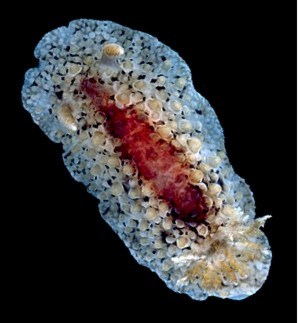
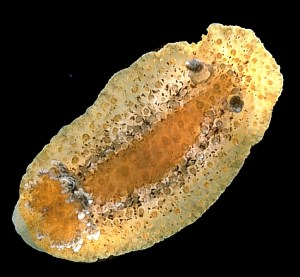
Rudman, W.B., 2000 (March 14) Hoplodoris nodulosa (Angas, 1864). [In] Sea Slug Forum. Australian Museum, Sydney. Available from http://www.seaslugforum.net/find/hoplnodu
Related messages
Re: Hoplodoris sp? from Townsville, QLD
March 18, 2008
From: David Mullins
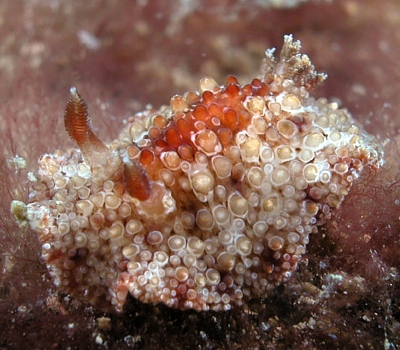
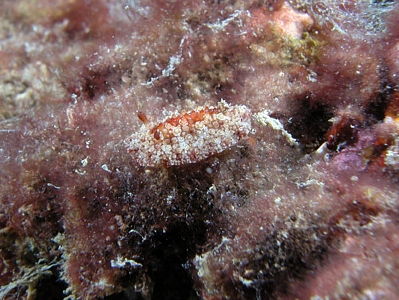
Concerning message #21191:
Dear Bill,
I notice you commented in the above message that the known distribution of Hoplodoris nodulosa is from southern temperate waters of Australia and New Zealand and that you didn't expect to have it reported from Townsville, Nthn Queensland. Perhaps Gary and I can help fill in some of the distribution gap with these specimens found on two occasions off Mooloolaba, Sthn Queensland in 2004.
Locality: Inner Gneerings, Mooloolaba, Sunshine Coast, 18 metres, Queensland, Australia., Pacific Ocean, 28 August 2004 & 28 December 2004, Rocky reef. Length: 50 mm. Photographer: David Mullins.
I don't think there is any doubt on the identification with the white rings around the packed brown pustules being the clincher.
David Mullins
david@nudibranch.com.au
Mullins,D.A., 2008 (Mar 18) Re: Hoplodoris sp? from Townsville, QLD. [Message in] Sea Slug Forum. Australian Museum, Sydney. Available from http://www.seaslugforum.net/find/21447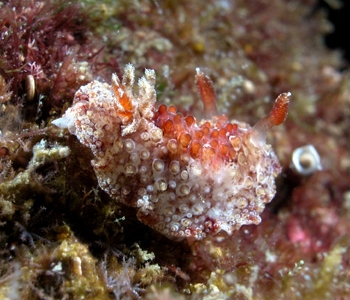
Dear David,
Thanks for the photos. I am afraid I can't go along with your enthusiasm for the white rings around the tubercles being an 'identification clincher'. If you look at the other species of Hoplodoris on the Forum quite a few have similar white rings. I learnt to be afraid of these 'nodulose dorids' 30 years ago in Tanzania when I thought I had one 'Hoplodoris' species from external appearances, but was puzzled by two or three subtle little differences such as the 'feel' of the live animal and the presence or absence of white flecks at the tip of the tubercles etc. When I came to dissect them I found I had three quite different reproductive systems, differences in radula etc, and despite detailed drawings and photos of all the living animals I could not successfully predict which species I had just by looing at the live animal.
So although I would like to think it is easy to identify species of Hoplodoris and other lookalikes, experience tells me to be wary.
Best wishes,
Bill Rudman
Hoplodoris sp? from Townsville, QLD
February 29, 2008
From: Melanie Wood
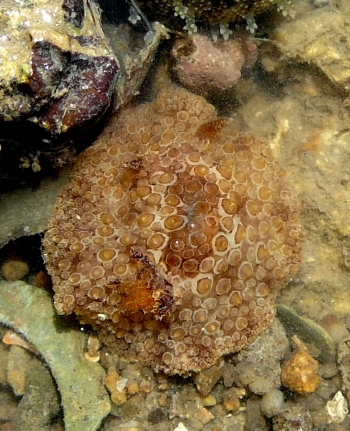
Hello,
I was hoping that I could get some aid in the identification of this nudibranch. I believe it is a Hoplodoris but I am unsure as to the species, there are a couple that I believe it may be.
As always, thank you for your great help and wonderful site!
Locality: Rowes Bay, Townsville, Low tide, exposed, Qld, Australia, 9 August 2007, Intertidal muddy. Length: Approximately 4cm. Photographer: Melanie Wood.
Melanie Wood
deadlegsmel@hotmail.com
Wood, M.J., 2008 (Feb 29) Hoplodoris sp? from Townsville, QLD. [Message in] Sea Slug Forum. Australian Museum, Sydney. Available from http://www.seaslugforum.net/find/21191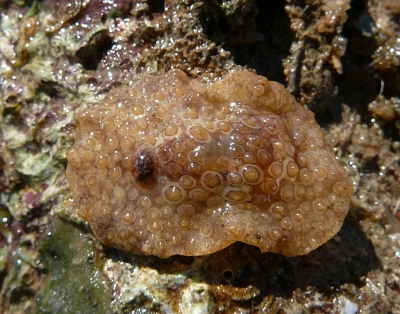
Dear Mel,
In general shape and colour I am pretty sure this is Hoplodoris nodulosa which is a bit puzzling as it is thought to have a distribution in the more temperate waters of sthn Australia and New Zealand. We have a specimen from Reunion Is, in the Indian Ocean [message #19494], which I have tentatively identified as the same species. If I am correct we would have to have a rethink.
Best wishes,
Bill Rudman
Hoplodoris flammea? from Reunion Island
May 3, 2007
From: Hugues Flodrops
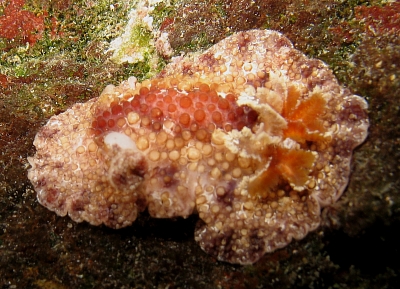
Dear Bill,
I found a new Hoplodoris about 35-40 mm. I think it is a Hoplodoris flammea for it's red central notum color.
On the Forum, apparently knows only from Bali (Gosliner 2003), we can add Reunion Island to the distribution list if you confirm identification.
Locality: Rocky coast, Etang-Salé, 0,30 metres, Reunion Island, Indian Ocean, 17 february 2007, Raining. Length: 35 mm. Photographer: Hugues Flodrops.
I'm sorry for the only photo on natural environnement but my batteries were empty.The others photos are taken on a mirror in one red box.
Thanks another time for your formidable forum.
Hugues.
hugues.flodrops@wanadoo.fr
Flodrops, H., 2007 (May 3) Hoplodoris flammea? from Reunion Island. [Message in] Sea Slug Forum. Australian Museum, Sydney. Available from http://www.seaslugforum.net/find/19494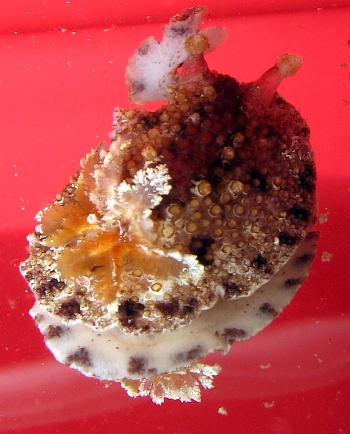
Dear Hugues,
I would be interested in Shireen Fahey's or Terry Gosliner's views on this specimen. To me, it is most similar to Hoplodoris nodulosa which is supposed to be restricted to temperate Australia and nthn New Zealand. That species also has the reddish brown central patch, and more importantly, usually has orange on the inside of the gills like in your animals.
Best wishes,
Bill Rudman
The identity of Homoiodoris novaezelandiae
November 10, 2006
From: Bill Rudman
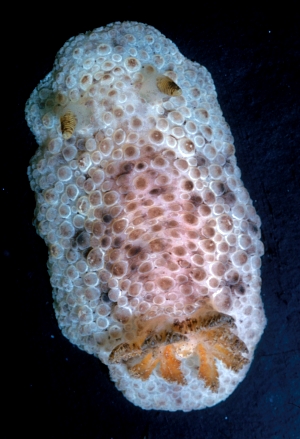
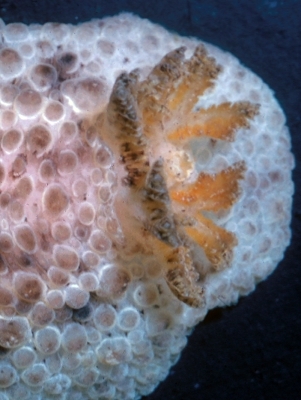
The message today from Kimberley Seaward [#18266 ] concerning Hoplodoris nodulosa is an opportune occasion to post this photo of it from New Zealand, kindly sent by Michael C. Miller. In New Zealand this species was known as Homoiodoris novaezelandiae Bergh, 1904 until Miller's review (1991) which showed that it was a species of Hoplodoris. On the evidence then available it was considered distinct from the eastern Australian Hoplodoris nodulosa. However, in Fahey & Gosliner's revision of the genus (2003), H. novaezelandiae is considered to be anatomically identical to H. nodulosa.
Photo: Aquarium Point, Portobello, Dunedin, New Zealand. 17 August 1962. Photo: M.C.Miller
- Fahey, S. J. and Gosliner, T. M. (2003) Mistaken identities: On the Discodorididae genera Hoplodoris Bergh, 1880 and Carminodoris Bergh, 1889 (Opisthobranchia: Nudibranchia). Proceedings of the California Academy of Sciences 54: 161-380.
- Miller, M. C. (1991) On the identity of the dorid nudibranch Homoiodoris novaezelandiae Bergh, 1904 (Gastropoda: Opisthobranchia). Journal of Natural History 25: 293-304.
Best wishes,
Bill Rudman
Hoplodoris nodulosa from Moeraki, South Island, New Zealand
November 10, 2006
From: Kimberley Seaward
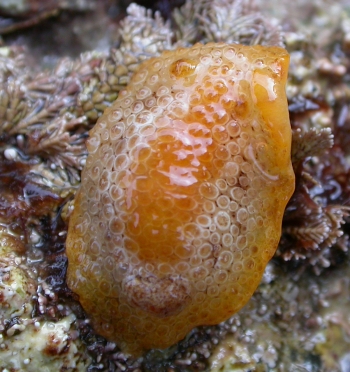
Concerning message #18129:
Dear Bill,
Here is a photo of a nudibranch I took on my recent trip to Moeraki. It was quite abundant, although I haven't even started to look to find out what they are.
Locality: Moeraki, Otago, South Island, New Zealand, east coast. Intertidal. 02 November 2006, Intertidal . Length: approx 3 cm. Photographer: Kimberley Seaward.
Thanks for informing me of what my previous nudibranch was, the colouring of the one I found in Kaikoura was very different to ones that have been found elsewhere. I was quite suprised.
Thanks
Kimberley
kimberley.seaward@canterbury.ac.nz
Seaward, K.J., 2006 (Nov 10) Hoplodoris nodulosa from Moeraki, South Island, New Zealand. [Message in] Sea Slug Forum. Australian Museum, Sydney. Available from http://www.seaslugforum.net/find/18266Dear Kimberley,
This is Hoplodoris nodulosa. As you will see from my separate message [#18267 ] it used to be known as Homoiodoris novaezelandiae and Hoplodoris novaezelandiae in New Zealand.
Best wishes,
Bill Rudman
Hoplodoris nodulosa from Nelson Bay
October 23, 2003
From: Dave Harasti
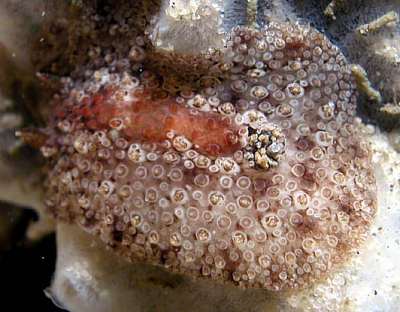
Dear Bill,
I have found quite a few species lately on night dives at Fly Point, Port Stephens, NSW, Australia that I can't identify from my books. This animal was found in Oct 2003, depth was approx 12 metres and water temp was 16 degrees.
Could you possibly please help with an ID?
Regards,
Dave Harasti
diving@webone.com.au
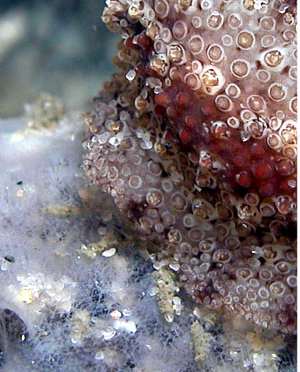
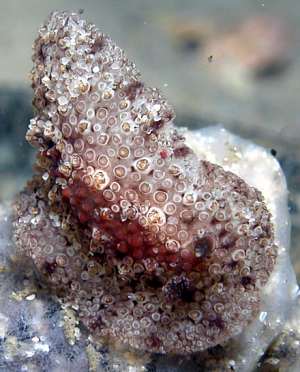
Dear Dave
This is Hoplodoris nodulosa, one of a group of 'nodulose' dorids which have recently been reviewed. See Shireen Fahey's message. Your photos of it on a white sponge are interesting, as it may be a clue to its food.
Best wishes
Bill Rudman
Unknown nudibranch from central New South Wales
March 15, 2000
From: Erik Schloegl
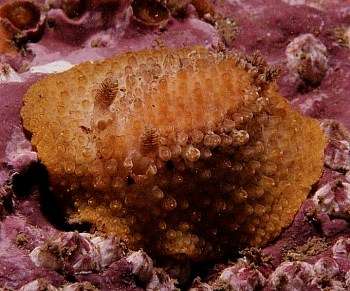
Dear Bill,
May I ask for an ID on this nudibranch? I found it at a depth of 15m on rocky reef, on November 7, 1998 at Moon Island, off Swansea on the Central Coast of New South Wales.
Best regards,
Erik Schloegl
schloegl@maths.uts.edu.au
Schloegl, E., 2000 (Mar 15) Unknown nudibranch from central New South Wales. [Message in] Sea Slug Forum. Australian Museum, Sydney. Available from http://www.seaslugforum.net/find/2069dear Erik,
This a Hoplodoris nodulosa another common southeastern Australian species I feel guilty about having avoided until know.
It was one of the first species described from Sydney Harbour (Angas, 1864) and is fairly easily identified from the large rounded nodules and the median patch on the mantle behind the rhinophores which is often devoid of nodules and usually a darker colour than the rest of the mantle.
Best wishes,
Bill Rudman.
